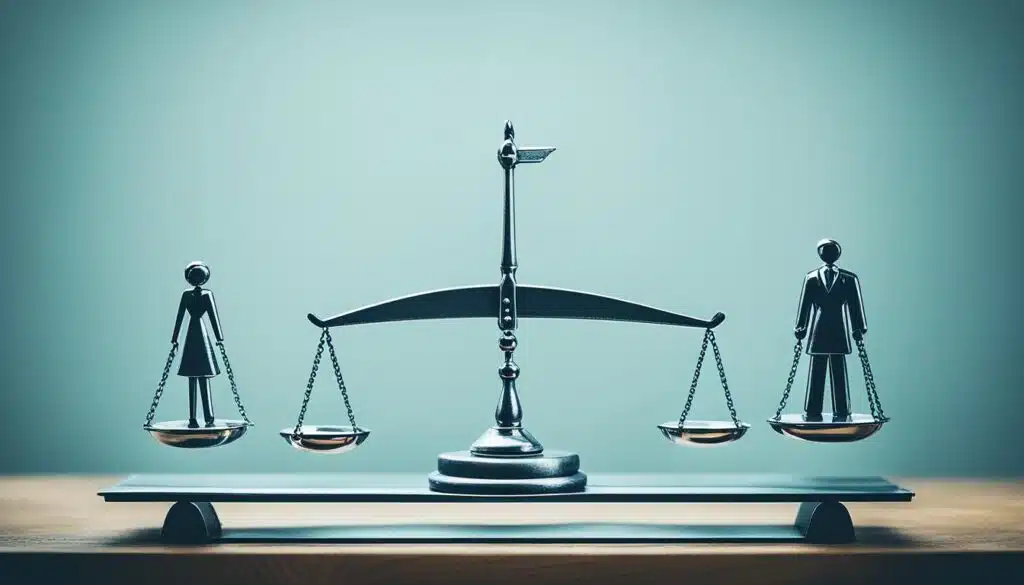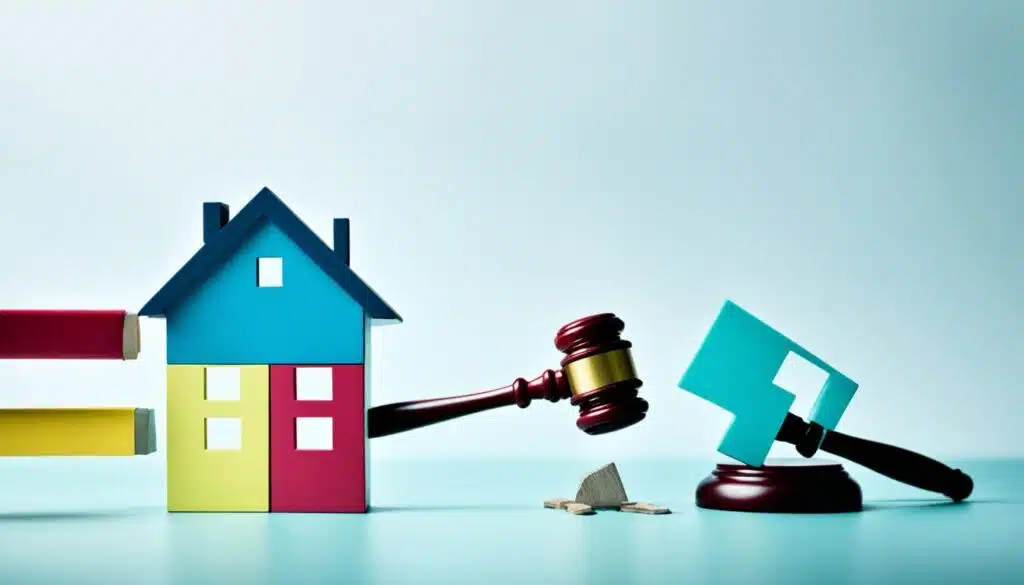For many parents, diving into child custody laws can be really tough during a divorce or breakup. It gets even more tricky when kids are part of the picture. The court or parents have to sort out who gets to make big calls for the children. They also have to figure out how everyone can see the kids.
This article will help break down the legal principles surrounding child custody. It covers what factors are looked at when deciding custody, parent rights and duties, how experts are involved in cases, and how to change custody or handle disagreements. Knowing these child custody laws is crucial for parents who want the best for their kids.
Key Takeaways
- Child custody laws cover who gets to look after and make decisions for kids in cases of divorce or separation.
- The main legal idea is doing what’s best for the child. This looks at the child’s health, if parents are suitable, and stability.
- Different agreements can be made for custody, which may include how much time each parent gets with the child.
- Sometimes, the court might ask for more info before they decide, like through custody evaluations.
- Mediation and other ways to solve disagreements can help parents figure out custody in a way they both agree on.
Also Read : The Importance Of Contract Law In Business
Introduction to Child Custody Laws
When a marriage ends, figuring out child custody is tough. The focus is on the child’s best interests. Parents need to grasp different types of child custody, including legal and physical. This knowledge is key for a smooth process.
Types of Custody Arrangements
Sole custody or joint custody are the two main types. Sole custody means one parent makes all the decisions. Joint custody allows both parents to decide together. There’s also sole legal custody, joint legal custody, sole physical custody, and joint physical custody.
Also Read : Types Of Legal Systems Around The World
Legal and Physical Custody Explained
Legal custody lets a parent make big decisions for the child. This involves education and healthcare. Physical custody is about where the child lives most of the time. Parents might have different arrangements for each, depending on their agreement.
Importance of Understanding Child Custody Laws
Knowing child custody laws and regulations is vital for divorcing parents. These laws can differ from state to state. Parents must learn about the family law and divorce rules in their area.
Legal Principles Governing Child Custody
In child custody decisions, the most important issue is what’s best for the child. Courts look into what would help the child’s health and happiness, putting the child’s needs first. They consider many things such as the child’s age and health, the parents’ health, and if there’s been any past issues like domestic violence, child abuse, or substance abuse.
Also Read : Top Patent Law Attorney For Your Innovation
Best Interests of the Child Standard
Making sure the child is safe and happy is key in custody cases. The focus is on the child’s needs, aiming to keep them close to both parents unless it’s not safe. They look at what’s best for the child, considering their relationship with the parents and their own wishes.
Factors Considered in Child Custody Decisions
Courts check if the parents are ready and the home is good for the child. They also look at the parents’ mental and physical health. Local laws help decide who will get custody, making sure the child’s best interests are always top priority.
Also Read : Advantages Of A Commercial Vehicle Accident Lawyer
Types of Child Custody Arrangements
Child custody comes in several types. Each affects what parents can decide and where the child lives. There are legal custody and physical custody. Legal custody lets parents make big choices for their kid. Physical custody decides where the child lives.
Sole Legal Custody
A parent with sole legal custody can decide on the child’s education, health, and upbringing alone. Courts prefer joint legal custody, unless there’s a good reason not to.
Also Read: Comprehensive IP Protection With Justice Law
Joint Legal Custody
Under joint legal custody, both parents share in deciding for the child. This way, both parents stay involved and make big choices together.
Sole Physical Custody
With sole physical custody, the child lives mostly with one parent. This parent cares for and supervises the child daily. The other parent may have visitation rights to see the child.
Joint Physical Custody
In a joint physical custody setup, the child spends substantial time with each parent. This helps the child have good relationships with both, as long as parents work well together.
The right child custody agreement is decided case by case. It looks at the family’s unique situation and what’s best for the child. Courts try to keep the child close to both parents for safety and well-being, if possible.
Child Custody Laws
State child custody laws mainly control child custody cases. There are also federal child custody laws that apply. Each state has made its own laws. These laws talk about what to consider when deciding on custody, changing custody orders, and how to make sure people follow custody agreements. There are also common laws that several states use to make things more fair.
On the federal side, we have laws like the Full Faith and Credit Given to Child Custody Determinations Act and the Child Support Enforcement Act. They help when there’s a interstate custody dispute or when we need to talk about child support. All these laws work toward what’s best for the child, looking at their well-being first. But, they also think about the parents’ rights. It’s really important for parents to know their state’s child custody regulations if they’re dealing with divorce and custody issues.
The Role of Parents in Child Custody Cases
Parents are key in child custody cases. The court aims to pick the setup that helps the child most. This means both parents have equal say in the child’s life.
Parental Rights and Responsibilities
When parents agree on how to raise their child, the court will likely say yes. This agreement should focus on what’s best for the child. It details where and with whom the child lives, when they see each parent, and who decides things for the child.
If parents can’t agree, the court steps in. They’ll decide custody based on what’s right for the child.
Parenting Plans and Custody Agreements
Sometimes, the court chooses joint custody. Here both mom and dad decide things together. But, sole custody might be picked if it’s better for the child. This often happens in more complicated situations.
Custody Evaluations and Assessments
In some tough child custody cases, courts may order child custody evaluations to learn more about the family situation. They aim to figure out the best custody plan for the child. Often, mental health professionals like child psychologists look at how the child interacts with each parent. They also check the parents’ parenting skills and health. Then, they give suggestions to the court.
The Importance of Custody Evaluations
The evaluation report is key for a judge’s decision on custody. Experts might testify in court about what they found. Even though custody evaluations take both money and time, they are very useful in tough cases. Especially where the child’s wellbeing is the main issue.
The Role of Experts in Custody Decisions
Child and family specialists and other mental health professionals give courts clear, detailed insights into the family’s situation. They work to find out the best custody choice for the child. Their expert testimony and suggestions, based on detailed court-ordered evaluations, can greatly affect a judge’s custody decision.
Types of Visitation Rights
When one parent has full custody, the other parent is often given visitation rights. This helps to keep the relationship with the child strong. Visits can be supervised, unsupervised, or done virtually.
Supervised Visitation
Supervised visitation involves a third-party monitor during visits. It’s used when there are safety concerns. This could be because of past abuse or drug use. It aims to protect the child during visits.
Unsupervised Visitation
The child can be with the other parent alone, if the court feels it’s safe. This might be at the other parent’s home. Or, it could be somewhere else both parents agree on. The court must trust the non-custodial parent to keep the child safe and happy.
Virtual Visitation
Virtual visitation means seeing the child through video calls. It’s helpful if the parents live far apart. Or, if there are other reasons they can’t meet in person. This can help keep the parent-child bond strong.
These visitation ways are decided by the court or in a parenting agreement. They focus on the child’s well-being most of all.
Custody Modifications and Legal Procedures
Child custody orders can change because family situations change. Parents can ask the court to change a custody agreement. This is if something big has happened that affects the child’s safety or well-being. For instance, a parent moving, a job change, getting married again, or issues like domestic violence can be reasons.
Substantial Change in Circumstances
To change custody, the parent asking must show it’s good for the child. The court then decides if the change is needed. The child’s stability and well-being are top concerns in these decisions.
Modification of Custody Orders
Changing a custody order involves legal steps and family court. It might include custody evaluations, mediation, or hearings. These steps make sure the child’s needs come first and that the changes are fair for everyone involved.
Mediation and Alternative Dispute Resolution in Custody Cases
Many states and courts push or even make parents try child custody mediation before heading to court over custody disputes. Mediation lets parents work together. They can find solutions that fit their family’s needs. This is better than having a judge decide for them.
Benefits of Mediation in Custody Disputes
The mediation process uses a neutral third party to help parents talk and negotiate. They discuss things like legal and physical custody and visitation schedules. Coming to an agreement in mediation can lower conflict and maintain healthy parent-child relationships. It also avoids the trouble and expense of going to court.
If mediation doesn’t work, parents can still turn to the courts. Yet, the process of mediation might offer them ideas for settling custody modifications later on.
The Mediation Process for Child Custody
In mediation, parents and the mediator make choices focused on the child’s best interests. They also consider each parent’s parental rights. The aim is to agree on a collaborative law that details custody and visits. This method is usually nicer and less hostile than fighting it out in court. It supports shared care and parenting.
Child Custody and Domestic Violence Issues
Claims of domestic violence or child abuse can hugely affect custody choices. Courts view these claims very seriously, focusing on the child’s safety and wellbeing. If proven, the court might give sole or primary custody to the non-violent parent.
Domestic Violence and Child Custody Decisions
At times, courts limit the violent parent’s visitation rights. They might allow only supervised visitation to keep the child safe. Also, protective orders could prevent the abuser from contacting the family.
Protective Orders and Custody Arrangements
The court considers evidence of abuse against the parent’s ability to create a safe, caring home. The goal is always to protect the child’s physical and emotional health.
Also Read : Expert Solicitor Advice For Your Legal Needs
Conclusion
Child custody laws are hard to understand, focusing on the child’s best interests. They look at different types of custody, parents’ rights, and the need for custody experts. They also consider how visits should work, changing orders, and handling domestic violence.
Although the rules might differ by state, they aim to keep the child safe. Knowing about these laws helps parents fight for what’s best for their family. The main goal for courts is the child’s safety and happiness.
Dealing with child custody can be tough, but knowing the laws and options helps. Parents need to think of their child first and work together. This could mean using mediation or going through the legal process to make fair custody decisions. These decisions provide safety, stability, and keep a strong bond with both parents.
FAQs
What are the different types of child custody arrangements?
Four main kinds of child custody exist. There’s sole legal custody, joint legal custody, sole physical custody, and joint physical custody. Families can mix these to suit their unique circumstances.
What is the difference between legal custody and physical custody?
Legal custody means the right to make key decisions about the child. This includes choices about school, health, and religion. Physical custody, on the other hand, is about where the child lives most.
Why is it important to understand child custody laws?
Knowing your state’s child custody laws is vital during a divorce or separation. These laws guide decisions about where the child lives and who makes key choices. They also help with any changes to these arrangements.
What is the “best interests of the child” standard?
The best interests of the child is the main rule for deciding custody. Courts look at what’s best for the child’s health, emotions, and mind when making decisions.
What factors do courts consider in child custody decisions?
Courts think about many things, like the child’s age and health, and the parents’ ability to care for them. They also consider the child’s relationship with each parent and the possibility of any danger to the child.
What are the different types of child custody arrangements?
Generally, custody can be legal or physical and be either sole or joint. Joint legal custody, where both parents share decision-making, is usually preferred by courts.
How are child custody laws determined?
States decide most child custody laws. These laws say what the court must think about when deciding on custody. There are also some national laws for cases involving more than one state.
What is the role of parents in child custody cases?
Parents are very important in custody cases. The court’s main goal is to find out what’s best for the child. They usually approve a custody plan made by the parents.
When are custody evaluations and assessments used?
In tough cases, the court might order a custody evaluation by a professional. This aims to get a better understanding of the family’s situation and to suggest the best arrangement for the child.
What types of visitation rights are available?
Visitation can be supervised, unsupervised, or even virtual. The details are usually in the court’s order or a plan agreed on by the parents.
How can child custody orders be modified?
If things change, parents can ask the court to adjust custody or visitation. They need to prove that the change will be better for the child.
What is the role of mediation in child custody cases?
Mediation is often suggested before going to court. It gives parents a chance to work together on a custody plan that fits their family. This approach is preferred over a judge making the decision.
How do issues of domestic violence impact child custody?
Domestic violence and child abuse are taken very seriously by the courts. If there’s evidence of abuse, the abusive parent might get limited visitation rights. The stay-safe approach for the child comes first.














